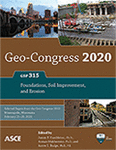Geo-Congress 2020
Case History of Column Cracking Due to Rotational Footing Movement at a Site in Los Angeles, California
Publication: Geo-Congress 2020: Foundations, Soil Improvement, and Erosion (GSP 315)
ABSTRACT
An existing building in California is being structurally modified. As part of the project, new foundations will be constructed adjacent to existing foundations. The level of groundwater is at the base of the foundations. During excavation adjacent to existing footings, cracks appeared on several columns. Survey data indicated that there was no measurable vertical movement of the columns or footings (within the tolerance of the survey), but the columns/footings moved 1/8 inch horizontally toward the excavation. A conclusion was reached that a small rotational movement of the footings occurred due to the excavation adjacent to the footings: the rotational movement induced shear stresses within the columns, resulting in diagonal cracks on the face of the columns. The excavation was completed and immediately backfilled with concrete. Crack gages were installed on columns and indicated that the movement ceased after the initial cracking. A comparison is made of the observed movement and the mechanism that would be expected in a conventional bearing capacity evaluation. In addition, the mechanism of translation of movement of the footing is evaluated relative to the observed deformation and cracking of the column. It is concluded that the observed movements are indicative of deformation consistent with conventional bearing capacity theory, despite a sufficient factor of safety being preserved during the construction activities.
Get full access to this article
View all available purchase options and get full access to this chapter.
REFERENCES
Brinch Hansen, J. (1970) “A Revised and Extended Formula for Bearing Capacity.” Danish Geotechnical Institute Bulletin No. 28.
Das, B. M. (2005) “Shallow Foundations – Bearing Capacity and Settlement.” Chapter 12 in Fundamentals of Geotechnical Engineering, 2nd Edition, Brooks/Cole Publishing Co.
Lyamin, A. V., R. Salgado, S.W. Sloan, and M. Prezzi (2006) “Two- and Three-Dimensional Bearing Capacity of Footings in Sand.” Available as a working paper at http://www.ecn.purdue.edu/~Rodrigo-papers
Meyerhoff, G. G. (1963) “Some Recent Research on the Bearing Capacity of Foundations.” Canadian Geotechnical Journal. 1, 16-26.
SCEDC (Southern California Earthquake Data Center). (2019) “2018 Catalog Data.” <http://service.scedc.caltech.edu/ftp/catalogs/SCSN/2018.catalog> (June 3, 2019).
USGS (United Stated Geological Survey). (2018) “Search Earthquake Catalog.” <https://earthquake.usgs.gov/earthquakes/search/>; (November 26, 2018).
Information & Authors
Information
Published In
Geo-Congress 2020: Foundations, Soil Improvement, and Erosion (GSP 315)
Pages: 362 - 369
Editors: James P. Hambleton, Ph.D., Northwestern University, Roman Makhnenko, Ph.D., University of Illinois at Urbana-Champaign, and Aaron S. Budge, Ph.D., Minnesota State University, Mankato
ISBN (Online): 978-0-7844-8278-0
Copyright
© 2020 American Society of Civil Engineers.
History
Published online: Feb 21, 2020
ASCE Technical Topics:
- Buildings
- Case studies
- Construction engineering
- Construction methods
- Continuum mechanics
- Cracking
- Dynamics (solid mechanics)
- Engineering fundamentals
- Engineering mechanics
- Excavation
- Existing buildings
- Footings
- Foundations
- Fracture mechanics
- Geotechnical engineering
- Methodology (by type)
- Motion (dynamics)
- Research methods (by type)
- Rotation
- Shallow foundations
- Shear stress
- Solid mechanics
- Stress (by type)
- Structural analysis
- Structural engineering
- Structures (by type)
Authors
Metrics & Citations
Metrics
Citations
Download citation
If you have the appropriate software installed, you can download article citation data to the citation manager of your choice. Simply select your manager software from the list below and click Download.
